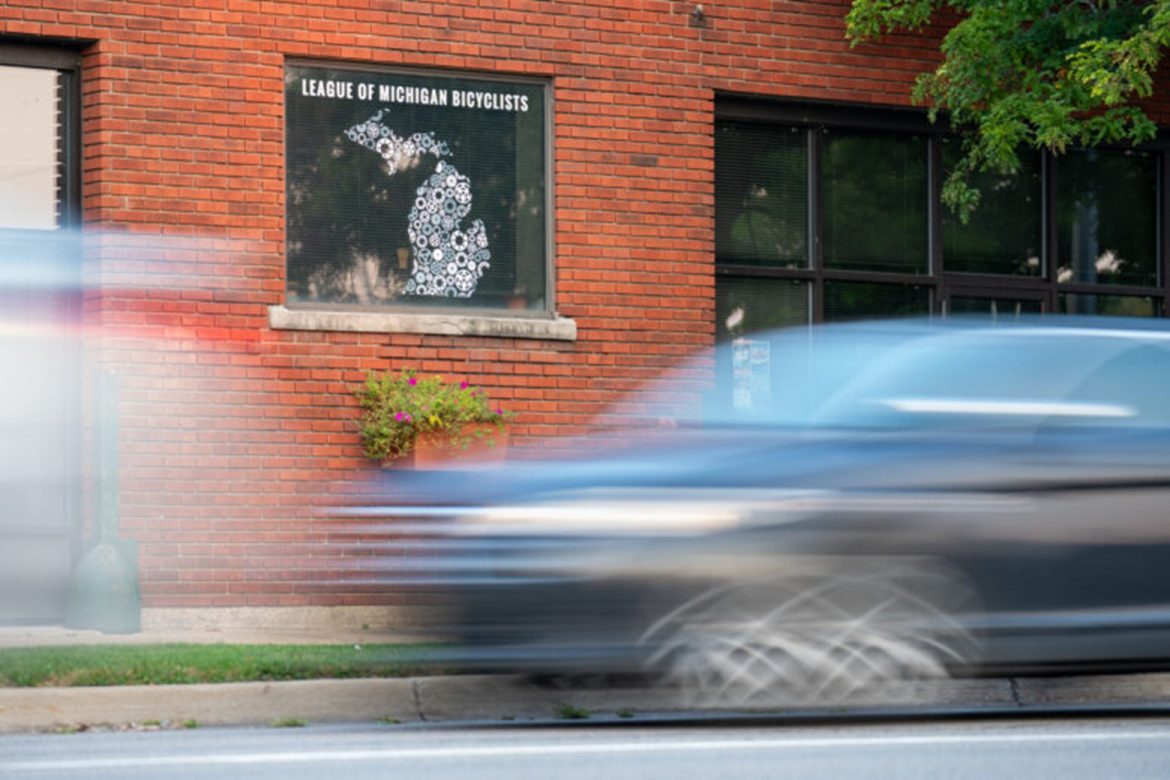
Cars pass in front of the League of Michigan Bicyclists office in Lansing, Michigan. Image: Donté Smith
By Donté Smith
The surge in electric bike (e-bike) sales has been nothing short of “obvious,” according to Rick Teranes, the co-owner of Bikes Blades & Boards in Grosse Pointe, Michigan
“Sales of e-bikes have multiplied in recent years,” Teranes said, highlighting the significant shift in Metro Detroit’s cycling landscape driven by their growing popularity.
And that has raised concerns about safety for e-cyclists, pedestrians and motorists.
In response to the increasing use of e-bikes, the Michigan Department of Natural Resources recently implemented a land use change, allowing Class 1 e-bikes on designated non-motorized trails.
Class 1 e-bikes provide pedal-assist without a throttle and can reach speeds up to 20 mph. Class 2 e-bikes have the same speed limit but include a throttle, allowing riders to accelerate without pedaling.
Nicole Hunt, the department’s regulatory unit manager, explained that the decision to allow e-bikes on trails was influenced by both state-level and federal considerations.
“Considering federal government recognition of e-bike use also was part of the process” Hunt said.
“The DNR’s decision to move forward with this proposed land use change wasn’t based on a desire to be trendy, but rather on providing individuals with more recreation options while also being conscientious of our state’s natural and cultural resources.”
However, Teranes cautions that policy changes alone do not guarantee safer riding conditions.
“A lot of new e-bike owners are new to cycling in general,” he said. “E-bikes are fast, and new riders need time to adjust.”
The League of Michigan Bicyclists has expressed concerns about the rapid increase in e-bike use.
John Lindenmayer, the league’s executive director, acknowledged that while more people riding bikes is generally positive, it also introduces new challenges.
“The same bicycle safety concerns apply to e-bikes,” Lindenmayer noted. “Drivers need to be more aware of their surroundings, put their phones down and avoid distractions.”
In 2023, Michigan saw an increase in road incidents involving pedestrians and cyclists, including e-bike riders. State Police data shows 2,114 pedestrian-related crashes and 1,480 involving bicyclists, marking an 11% rise in pedestrian crashes and a 10% increase in those involving cyclists compared to 2022.
In May, a 28-year-old woman was fatally struck by a turning truck while riding her e-bike in Grand Rapids. In June, a 64-year-old man was killed in an intersection near Ypsilanti when a vehicle hit him on his e-bike.
Lindenmayer stressed that safety is a shared responsibility.
“New e-bike users should take it slow and get comfortable with handling the bike,” he said. “Avoid accelerating too quickly, which has led to some crashes.”
He also emphasized the importance of proper lane positioning and visibility — through adequate lighting and bright clothing — to reduce accidents as e-bikes become more common on roads across the state.
Teranes echoed these concerns, noting that many new customers at his shop lack fundamental safety knowledge.
“As participation goes up, injuries will go up,” Teranes said. “Safety education is crucial for new e-bike riders.”
Lindenmayer said maintenance is another issue. “Bike lanes are sometimes built but not properly maintained or cleared of sand, broken glass, snow and other debris.”
“Communities across Metro Detroit would benefit from investing in better bicycle infrastructure,” he said. “Separated bike lanes that offer physical protection between drivers and cyclists would help reduce conflicts, prevent crashes and encourage more people to ride.”
The league has intensified efforts to educate both drivers and cyclists.
For example, the organization has distributed an “E-bike Etiquette and Trail Access” guide to bike shops across the state, offering practical tips for safer riding.
It is also advocating for a statewide e-bike incentive program to make e-bikes more affordable, particularly for low-income households.
According to the National Conference of State Legislatures, the average cost of an e-bike ranges from $2,000 to $3,000, double the average price of a conventional commuter bicycle.
As communities adapt to their rising popularity, balancing growth with safety remains a top priority, Teranes and Lindenmayer said.
Continued efforts to improve infrastructure, educate users and address safety concerns will be crucial as e-bikes become an increasingly common feature of the state’s transportation landscape, they said.
Donté Smith reports for Capital News Service.
